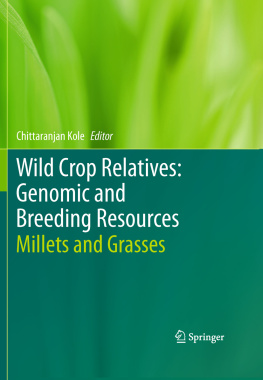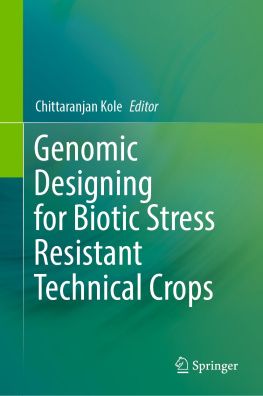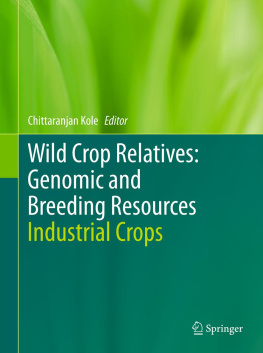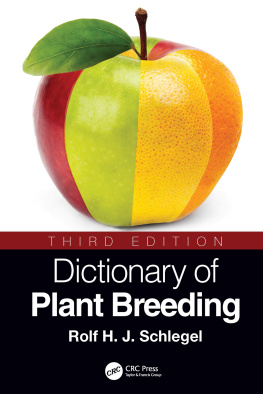Chittaranjan Kole - Wild Crop Relatives: Genomic and Breeding Resources
Here you can read online Chittaranjan Kole - Wild Crop Relatives: Genomic and Breeding Resources full text of the book (entire story) in english for free. Download pdf and epub, get meaning, cover and reviews about this ebook. City: Berlin;Heidelberg, year: 2011, publisher: Springer, genre: Romance novel. Description of the work, (preface) as well as reviews are available. Best literature library LitArk.com created for fans of good reading and offers a wide selection of genres:
Romance novel
Science fiction
Adventure
Detective
Science
History
Home and family
Prose
Art
Politics
Computer
Non-fiction
Religion
Business
Children
Humor
Choose a favorite category and find really read worthwhile books. Enjoy immersion in the world of imagination, feel the emotions of the characters or learn something new for yourself, make an fascinating discovery.
- Book:Wild Crop Relatives: Genomic and Breeding Resources
- Author:
- Publisher:Springer
- Genre:
- Year:2011
- City:Berlin;Heidelberg
- Rating:4 / 5
- Favourites:Add to favourites
- Your mark:
- 80
- 1
- 2
- 3
- 4
- 5
Wild Crop Relatives: Genomic and Breeding Resources: summary, description and annotation
We offer to read an annotation, description, summary or preface (depends on what the author of the book "Wild Crop Relatives: Genomic and Breeding Resources" wrote himself). If you haven't found the necessary information about the book — write in the comments, we will try to find it.
Wild Crop Relatives: Genomic and Breeding Resources — read online for free the complete book (whole text) full work
Below is the text of the book, divided by pages. System saving the place of the last page read, allows you to conveniently read the book "Wild Crop Relatives: Genomic and Breeding Resources" online for free, without having to search again every time where you left off. Put a bookmark, and you can go to the page where you finished reading at any time.
Font size:
Interval:
Bookmark:
B. S. Ozdemir and H. Budak1
| (1) | Engineering and Natural Sciences, Biological Sciences and Bioengineering Program, Sabanci University, Orhanli, 34956 Tuzla, Istanbul, Turkey |
 | H.Budak Email: |
The grass family (Poaceae) emerged 60 million years ago (Kellogg ).
Agrostis spp., bentgrass, contains more than 200 perennial turfgrass species as a genus in the Poaceae family (Hitchcock ).
Bentgrasses are cool-season grasses that are widely used on golf courses (tees, fairways, and greens) at temperate regions due to their dense nature, low mowing heights without damage, and green appearance. They are also used for parks and forage. They are cross-pollinating, self-incompatible, and pollinated by wind. Agrostis can exhibit both clonal growth and seed reproduction.
It is hard to classify Agrostis genus taxonomically. Due to the similar morphological characters among this genus, others features are needed to be included for identification of new germplasms. Laser flow cytometry for the determination of ploidy level was found to be effective in differentiating between diploid, tetraploid, and hexaploid forms by evaluating six Agrostis species; A. canina L. subsp. canina, A. canina L. subsp. montana (Hartm.) Hartm., A. stolonifera var. palustris (Huds.) Farw., A. capillaris L., A. castellana Boiss. & Reut., and Agrostis alba L. (Bonos et al. ).
Creeping bentgrass is a cool-season grass species that is native to Western Europe. It is not only adapted to cool and humid areas but also preferred to be used in warmer places at golf courses due to its fine texture. Creeping bentgrass has high density and mowing height as low as 3mm; these features make it suitable to be used especially in greens though it is also used in tees and fairways of the golf courses (Warnke ).
Creeping bentgrass is commonly referred to as A. stolonifera L., but other synonyms are also used such as Agrostis palustris Huds. and A. stolonifera L. var. palustris (Huds.). It is a strict allotetraploid with a genome A2A2A3A3 (2n=4x=28) (Warnke ).
Creeping bentgrass requires vernalization, and flowering occurs generally in late spring to early summer (Warnke ). Interspecific hybridization of creeping bentgrass is possible with five different Agrostis species (A. canina L., A. castellana Boiss. & Reut, A. gigantea Roth, A. capillaris L., and A. vinealis Schreb).
Due to its stoloniferous growth, thick thatch layers can be formed, if it is not managed properly. This then serves as a good environment for pathogens and insects. It is susceptible to many diseases, but dollar spot (Sclerotinia homeocarpa), brown patch (Rhizoctonia solani), Typhula blight (Typhula incarnata or Typhula ishikariensis), the so-called gray snow mold, and Fusarium blight (Fusarium roseum and Fusarium tricinctum), also named as pink snow mold, are the main concerns.
A study with rhizobacteria, isolated from roots of bentgrass and bermudagrass located from USGA golf putting greens, showed that Pseudomonas was the dominant genus in the roots of bentgrass for denitrification. For both species, 17% of the isolates were identified by GC-FAME (gas chromatography fatty acid methyl ester) and 16S rDNA analyses. Besides, nitrous oxide reductase (nosZ) and nitrite reductase genes (nirK and nirS) were recognized (Wang and Skipper ).
Colonial bentgrass is both referred as A. capillaris L. and Agrostis tenuis Sibth. Origin of colonial bentgrass is Europe and temperate Asia. It is a cool-season grass and also named as brown top. While it is used in lawns and sports fields such as tennis courts and golf courses, it is also a choice for erosion control (Hubbard ).
Colonial bentgrass is preferred on fairways and tees at golf courses with a mowing height of 1.02.5cm; hence, it is not much suitable for greens. It has lower maintenance needs than creeping bentgrass; instead it has more limitations (Ruemmele ).
The colonial bentgrass (A. capillaris L.) with the genome A1A1A2A2 and creeping bentgrass (A. stolonifera L.) with the genome A2A2A3A3 are both allotetraploid and have 14 chromosome pairs (2n=4x=28) (Ruemmele ). Since they are sexually compatible, hybrids can be produced.
Genomics studies facilitate analysis of many species for their origin and evolution with the use of many tools it provides. Expressed sequence tag (EST) sequence analysis of colonial and creeping bentgrass A2 genomes suggested that these genomes diverged from a common ancestor at about 2.2 million years ago and supported the previous studies that A2 genomes were common for both species. Their findings also showed that both creeping and colonial bentgrasses were closer to tribe Poeae than tribe Aveneae that are actually closely related tribes (Rotter et al. ).
Velvet bentgrass is referred as A. canina L., which is native to Europe. It is diploid (2n=2x=14) with genome designation of A1A1. It is confused widely with A. vinealis (2n=4x=28) which is an autotetraploid of A. canina.
Velvet bentgrass is a cool-season grass with very fine texture, maintaining a good putting surface at golf courses, and it has stoloniferous growth habit. It is the most shade-tolerant among other Agrostis spp. It has good heat, low temperature, and drought tolerance. Besides, it is more tolerant to acidic soils then all other bentgrasses. However, it needs high maintenance (Brilman ).
Font size:
Interval:
Bookmark:
Similar books «Wild Crop Relatives: Genomic and Breeding Resources»
Look at similar books to Wild Crop Relatives: Genomic and Breeding Resources. We have selected literature similar in name and meaning in the hope of providing readers with more options to find new, interesting, not yet read works.
Discussion, reviews of the book Wild Crop Relatives: Genomic and Breeding Resources and just readers' own opinions. Leave your comments, write what you think about the work, its meaning or the main characters. Specify what exactly you liked and what you didn't like, and why you think so.











